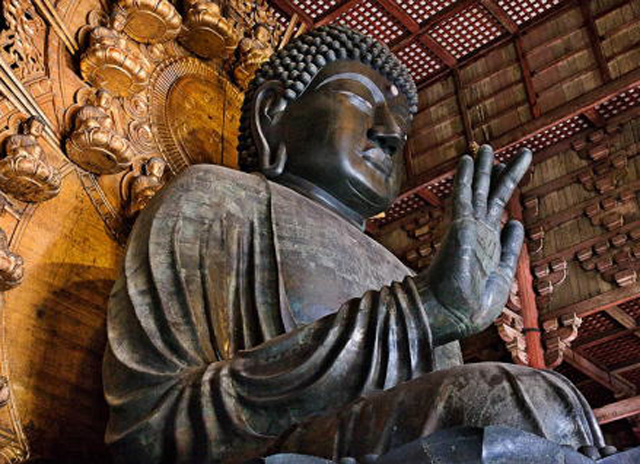HOME → 世界文化遺産でたどる日本史 → 古都奈良の文化財

Historic Monuments of Ancient Nara

-
古都奈良の文化財(奈良県奈良市、世界遺産登録1998年)
古代、日本の文化は大陸との交流によって、大きく発展しました。8世紀初頭には、奈良に都(平城京)が造営され、国家や文化の重要な基礎が築かれました。奈良では6つの寺社、平城宮跡と春日山の原生林が世界文化遺産になっています。
-
【文化遺産オンライン(文化庁)】
http://bunka.nii.ac.jp/jp/world/h_07.html -
【奈良市観光協会】
http://narashikanko.or.jp/index.php
-
【文化遺産オンライン(文化庁)】
-
Historic Monuments of Ancient Nara
In ancient times, Japanese culture developed significantly through exchange with the Asian continent. In the early eighth century, Japan's capital was established in ancient Nara (then known as Heijokyo), forming an important foundation for the nation and its culture. In Nara, six temples and shrines, the Heijo Palace ruins, and the Kasugayama Primeval Forest have been designated World Heritage Sites.
-
【UNESCO World Heritage Center】
http://whc.unesco.org/en/list/870 -
【Nara tourism bureau】
http://narashikanko.or.jp/en/
-
【UNESCO World Heritage Center】
-
古都奈良的文化遗产
在古代,日本文化是在和大陆的交流中逐渐发展起来的。8世纪初京城(平城京)在奈良兴建,奠定了国家和文化发展的重要基石。奈良六座寺庙神社、平城宫遗迹及春日山原始森林是世界文化遗产。
-
【奈良市観光協会】
http://narashikanko.or.jp/cn
-
【奈良市観光協会】
-
古都奈良的文化財
古代時,在日本與大陸的交流之下,日本文化得到了極大發展。八世紀初於奈良建造了首都(平城京),奠立了國家及文化的重要基礎。奈良的六所寺院神社、平城宮跡及春日山原生林是世界文化遺產。
-
【奈良市観光協会】
http://narashikanko.or.jp/tw/
-
【奈良市観光協会】
-
나라 역사기념물
고대의 일본문화는 대륙과의 교류를 통해 크게 발전했습니다. 8세기 초에는 나라에 수도(헤이조쿄)가 조영되어 국가와 문화의 중요한 기초가 이루어졌습니다.
나라에는 6개의 사원과 신사, 헤이조큐세키(헤이조궁터)와 가스가야마 원시림이 세계문화유산으로 지정되어 있습니다.-
【奈良市観光協会】
http://narashikanko.or.jp/kr/
-
【奈良市観光協会】
-
Monuments historiques de l'ancienne Nara
Dans l'antiquité, la culture japonaise a connu un important développement à travers ses échanges avec le continent. Au début du 8ème siècle, une capitale a été établie à Nara (Heijo-kyo) pour constituer une base importante de l'Etat et de la culture. A Nara, 6 temples et sanctuaire, le site archéologique du palais de Nara et la forêt primitive de Kasugayama composent ce site du Patrimoine culturel mondial.
-
【UNESCO World Heritage Center】
http://whc.unesco.org/en/list/870
Retour sur l'histoire du Japon à travers son Patrimoine culturel mondial
-
【UNESCO World Heritage Center】
-
Historische Stätten des alten Nara
Im Altertum machte die japanische Kultur durch den Kontakt mit dem asiatischen Kontinent eine große Entwicklung durch. Anfang des 8. Jahrhunderts wurde in Nara die Hauptstadt (Heijo-kyo) errichtet und so ein wichtiges Fundament für den Staat und die Kultur Japans gelegt. In Nara sind sechs Tempel und Schreine, die Ruine des Heijo-Palastes und der Primärwald des Kasugayama Teil des Weltkulturerbes geworden.
Ein Gang durch die japanische Geschichte anhand des Weltkulturerbes
-
I monumenti storici dell'antica Nara
In epoca antica la cultura giapponese si sviluppò grandemente grazie agli scambi con il continente cinese. All'inizio dell'ottavo secolo a Nara fu costruita la capitale (chiamata Heijōkyō), e con essa furono stabilite le importanti fondamenta delle istituzioni statali e della cultura. A Nara sei edifici tra templi buddhisti e santuari shintoisti, oltre che alle rovine di Heijōkyō e alla foresta vergine di Kasugayama, sono registrati tra i patrimoni dell'umanità.
-
Monumentos históricos de la antigua Nara
La cultura de Japón avanzó enormemente en la antigüedad po el intercambio con el continente. A principios del siglo VIII Nara se convirtió en la capital (Capital Heijo-kyo), y se construyó una base importante del estado y la cultura. El Patrimonio Cultural de la Humanidad en Nara son 6 templos y santuarios, el Palacio Heijo y el Bosque de Kasugayama.
La Historia de Japón a través del Patrimonio Cultural de la Humanidad
-
Monumentos Históricos da Antiga Nara
Na antiguidade, desenvolveram-se muito as trocas culturais do Japão com o continente. A capital Nara (Capital Heijo-kyo) foi fundada no início do século VIII, construindo importantes bases da nação, cultura, etc. Os 6 templos de Nara, as ruínas do palácio Heijo e bosques deKasugayama estão classificados como património mundial e cultural.
-
【Nara Pref】
http://www.pref.nara.jp/nara_p/
Seguindo a história do Japão através do seu património mundial e cultural
-
【Nara Pref】
-
Историческое наследие древней столицы Нара
В древности развитие Японии было в большой части обусловлено сношениями с материком. В начале 8 века в Наре была основана столица (Хэйдзё-кё), и заложены основы государства и культуры. Из Всемирного культурного наследия в Наре находятся 6 буддийских и синтоистских храмов, руины дворца Хэйдзё и первобытный лес горы Касуга.

